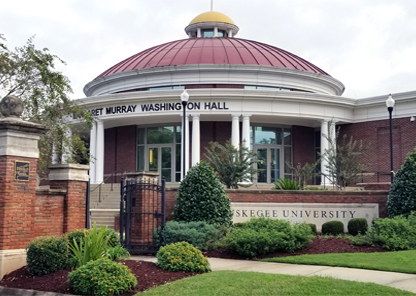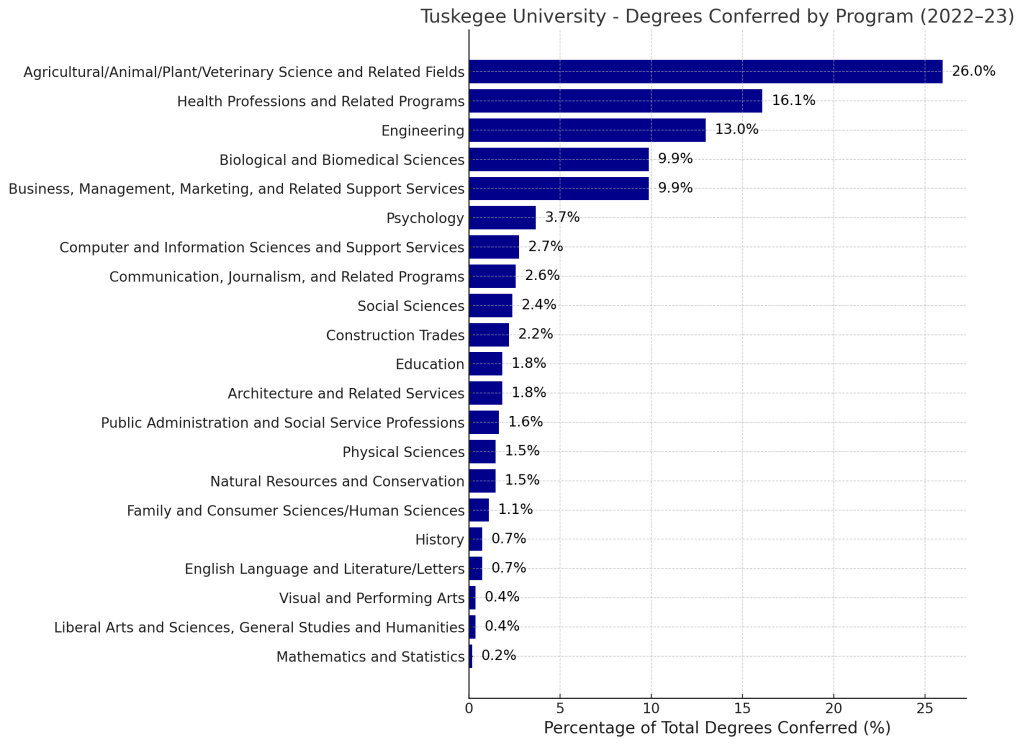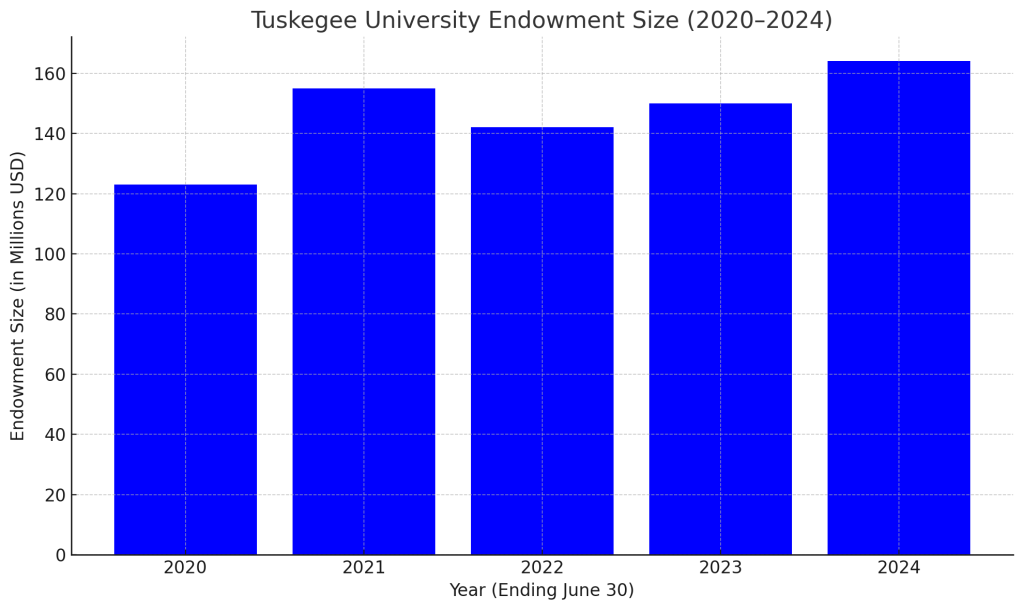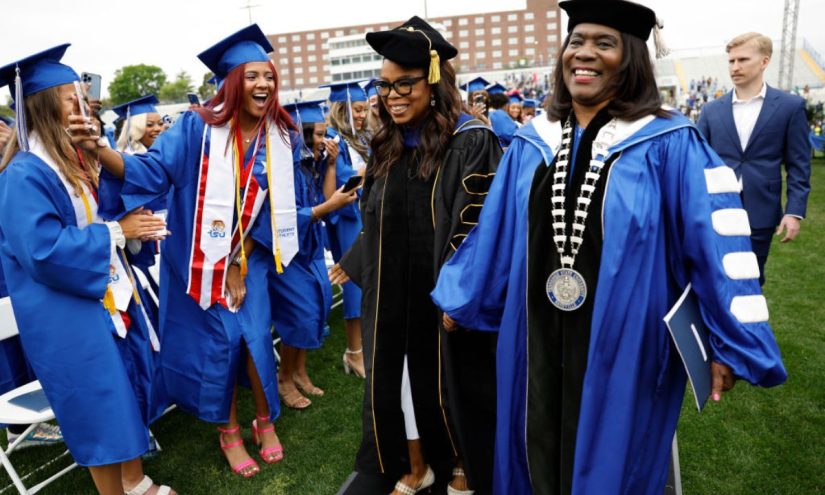Category: HBCU
-

Deadly Lincoln University mass shooting: Vigil held on campus; investigation continues (Fox 29 Philadelphia)
Detectives believe multiple shooters were involved in a mass shooting that occurred during Lincoln University’s homecoming that left a 20-year-old Wilmington, Delaware man dead and six others injured. -

Tuskegee University – Edu Alliance Journal
April 14, 2025, by Dean Hoke: This profile of Tuskegee University is the ninth in a series presenting small colleges throughout the United States.
Background
Founded in 1881 by educator Booker T. Washington, Tuskegee University is a private historically black university (HBCU) located in Tuskegee, Alabama – about 40 miles east of Montgomery . Established initially as the Tuskegee Normal School for training Black teachers, it evolved into Tuskegee Institute and eventually a university known for blending liberal arts, technical, and professional education. The university’s campus, a designated National Historic Site, spans roughly 5,000 acres (including a 450-acre main campus and extensive forestry and research lands). Tuskegee is consistently ranked among the top HBCUs nationally (U.S. News #3 in 2023) and is noted for its academic rigor and legacy of producing African American leaders.
Curricula
Tuskegee offers a broad curriculum encompassing over 50 degree programs. Programs include Engineering, Architecture, Business, Education, and Nursing & Allied Health, as well as a renowned College of Veterinary Medicine. The university balances a liberal arts foundation with strong STEM and professional programs. Students complete a liberal arts core while pursuing majors in fields like engineering, agriculture, the sciences, business, and the humanities. Tuskegee has introduced distinctive programs that leverage its heritage – for example, it hosts the nation’s only Aerospace Engineering program at an HBCU, and it houses a National Center for Bioethics in Research and Health Care focused on minority health ethics.
Experiential learning is integral: from engineering design projects to agricultural research and Cooperative Extension outreach in rural communities, students get hands-on training. Notably, Tuskegee’s veterinary medicine program, founded in 1945, provides crucial clinical experience and has become a top producer of minority veterinarians. Outcomes for graduates are strong in many programs – for example, nursing and allied health majors benefit from clinical partnerships, and engineering students often secure competitive internships. Tuskegee reports in 2022, the four-year graduation rate is 33%, and the six-year graduation rate is 67%.
Strengths
- Historic Legacy and Mission: Tuskegee’s history is a cornerstone of its identity. It was built on Booker T. Washington’s self-help philosophy and has played a pivotal role in African American education for over a century.
- Excellence in STEM, Agriculture, and Veterinary Medicine: The university is a powerhouse in STEM fields. It is the only independent HBCU with four ABET-accredited engineering programs and the only HBCU with an Aerospace Science Engineering program. Its College of Veterinary Medicine has educated over 70% of African American veterinarians in the United States.
- Strong Student Outcomes and Recognition: Tuskegee is recognized for improving social mobility and student success. U.S. News ranks Tuskegee #1 among Southern schools for social mobility and among the top 5 HBCUs nationwide. The university has produced generations of leaders and pioneers, which bolsters its reputation and provides current students with role models and mentors.
- Community Engagement and Service: As a land-grant institution, Tuskegee is deeply committed to community service and outreach. Through its Cooperative Extension Program and initiatives like the new Center for Rural Health and Economic Equity, the university addresses needs in Alabama’s Black Belt region—from agricultural assistance for local farmers to health equity research for underserved rural populations.
Weaknesses
- Enrollment Decline: Tuskegee’s Full-Time Equivalent (FTE) enrollment has steadily decreased from 3,276 in 2019 to a low of 2,755 in 2023, with a modest rebound to 2,881 in 2024. This downward trend, though not unique among small institutions, negatively impacts tuition revenue, national rankings, and institutional perception.
- Infrastructure and Facilities: Numerous campus buildings require modernization. Students and alumni on platforms like UNIGO have expressed concerns about aging dormitories and outdated lab and classroom technology. These issues pose challenges for student recruitment and retention, especially in STEM disciplines. The university acknowledged these concerns in 2024 and stated that actions are underway to address construction delays.
- Return on Investment (ROI): According to Georgetown University’s Center on Education and the Workforce, Tuskegee’s 40-year ROI for bachelor’s degrees is $1,434,000—well below the national average of $1,744,000 for private institutions. This places Tuskegee in the lower 20th percentile nationally and may raise concerns among prospective students and families weighing the long-term value of a Tuskegee degree.
Note: Tuskegee does an exceptional job with the students it serves, often outperforming peers in helping students succeed and move up economically. However, its graduates’ average earnings are lower than those of graduates from many other private institutions, which affects ROI rankings. This contrast is common among mission-driven institutions that serve high-need populations and public interest-oriented fields (e.g., education, social work, veterinary medicine), where average salaries tend to be lower despite high societal value.
Economic Impact
Tuskegee University is a major economic engine for its region. According to the United Negro College Fund’s (UNCF) 2024 Economic Impact Report, Tuskegee University contributes approximately $237.1 million annually to Alabama’s economy and supports 2,064 jobs statewide through its operations, payroll, student spending, and visitor expenditures. It is one of the largest employers in Macon County, with nearly 1,400 employees on payroll, and its presence stimulates additional employment in the community (restaurants, shops, services that cater to students and employees).
Beyond direct spending, as a land-grant institution, it operates Cooperative Extension programs that improve agricultural productivity and entrepreneurship in rural Alabama. The university actively pursues research grants that address local needs. For example, in 2023, Tuskegee received a $2.2 million federal grant to establish a Center for Rural Health and Economic Equity, which will not only improve healthcare outcomes in Black Belt counties but also create research jobs and community health worker positions.
Enrollment Trends
As of Fall 2024, total enrollment (FTE) is 2881 students, including undergraduates, graduate students, and professional students in veterinary medicine.
The university has actively recruited beyond Alabama: currently, only 26% of undergraduates are Alabama residents, while 74% come from out-of-state.
Degrees Awarded by Major
In the 2022–23 academic year, Tuskegee University conferred 547 degrees in total (410 bachelor’s, 69 master’s, and 68 doctorates, including professional degrees).

Alumni
Tuskegee University boasts a vibrant alumni network of tens of thousands of graduates spread across the U.S. and abroad. With nearly 140 years of history, Tuskegee has produced generations of African American professionals and leaders, creating an expansive community often referred to as the “Tuskegee Family.” Alumni remain closely connected to the university and each other.
Notable Alumni and Figures: Tuskegee’s alumni and associated figures include some of the most influential names in U.S. education, science, military, and culture:
- Amelia Boynton Robinson (Class of 1927): Pioneering civil rights activist and leader in the voting rights movement. She played a key role in the 1965 Selma to Montgomery marches, inviting Dr. Martin Luther King Jr. to Selma.
- Gen. Daniel “Chappie” James (Class of 1942): The first African American four-star general in U.S. military history.
- Lonnie Johnson (Class of 1973): Engineer and inventor, Johnson, a Tuskegee mechanical engineering graduate, had a distinguished career at the Air Force and NASA before his entrepreneurial success. He holds over 100 patents.
- Lionel Richie (Class of 1974): Grammy-winning singer, songwriter, and former lead vocalist of the Commodores. Richie, a Tuskegee native, graduated with an economics degree.
- Keenen Ivory Wayans (Attended from 1977-1980): an American actor, comedian, director, and filmmaker who co-hosted and created the TV comedy Emmy award show In Living Color. An engineering student on scholarship, he left Tuskegee in his senior year to pursue acting.
Endowment and Financial Standing
Tuskegee University’s financial foundation is solid but underpins a careful stewardship to meet institutional needs. As of 2024, the university’s endowment is valued at around $161 million. It remains smaller than some peer HBCUs. The university still depends heavily on tuition and fees. A milestone came in 2020 when philanthropist MacKenzie Scott donated $20 million to Tuskegee – the largest gift in the university’s history.

The university’s financial management has earned positive marks. The 2023 Forbes Financial Grades gives Tuskegee a 3.82 GPA and a letter grade of A-.
Why is Tuskegee Important?
- Tuskegee University holds a singular place in American higher education and society, with a legacy and ongoing impact that extend far beyond its small-town Alabama campus. Founded in an era of segregation and limited opportunities for Black Americans, Tuskegee became a beacon of self-determination – educating Black teachers, farmers, and craftsmen in its early years and proving that excellence could flourish under the most challenging conditions.
- Tuskegee’s importance also lies in its academic and professional contributions, particularly in increasing diversity in critical fields. It has been a prolific producer of African American professionals: for example, as noted, the vast majority of Black veterinarians are Tuskegee graduates, and the university has trained countless Black engineers, nurses, and scientists.
- Tuskegee University remains a cultural touchstone and symbol of excellence. Tuskegee has also influenced educational models worldwide; notably, its extension work and vocational training approaches were emulated in developing nations (especially in Africa) during the 20th century, spreading the ethos of education for empowerment globally.
In summary, Tuskegee University is important because it represents the power of education as a force for equality and innovation. It has transformed lives and communities for generations, contributed richly to African American history and American progress, and continues to produce leaders and ideas that shape our world. In American higher education, Tuskegee’s thread is unique and invaluable – an embodiment of resilience, excellence, and the ongoing pursuit of knowledge for the betterment of society.
Dean Hoke is Managing Partner of Edu Alliance Group, a higher education consultancy, and a Senior Fellow with the Sagamore Institute. He formerly served as President/CEO of the American Association of University Administrators (AAUA). With decades of experience in higher education leadership, consulting, and institutional strategy, he brings a wealth of knowledge on small colleges’ challenges and opportunities. Dean, along with Kent Barnds, is a co-host for the podcast series Small College America.
-

Black Colleges Ponder Their Future As Trump Makes Cuts to Education Dollars – The 74
Get stories like this delivered straight to your inbox. Sign up for The 74 Newsletter
The nation’s historically Black colleges and universities, known as HBCUs, are wondering how to survive in an uncertain and contentious educational climate as the Trump administration downsizes the scope and purpose of the U.S. Department of Education — while cutting away at federal funding for higher education.
In January, President Donald Trump signed an executive order pausing federal grants and loans, alarming HBCUs, where most students rely on Pell Grants or federal aid. The order was later rescinded, but ongoing cuts leave key support systems in political limbo, said Denise Smith, deputy director of higher education policy and a senior fellow at The Century Foundation, a left-leaning think tank.
Leaders worry about Trump’s rollback of the Justice40 Initiative, a climate change program that relied on HBCUs to tackle environmental justice issues, she said. And there’s uncertainty around programs such as federal work-study and TRIO, which provides college access services to disadvantaged students.
“People are being mum because we’re starting to see a chilling effect,” Smith said. “There’s real fear that resources could be lost at any moment — even the ones schools already know they need to survive.”
Most students at HBCUs rely on Pell Grants or other federal aid, and a fifth of Black college graduates matriculate from HBCUs. Other minority-serving institutions, known as MSIs, that focus on Hispanic and American Indian populations also heavily depend on federal aid.
“It’s still unclear what these cuts will mean for HBCUs and MSIs, even though they’re supposedly protected,” Smith said.
States may be unlikely to make up any potential federal funding cuts to their public HBCUs. And the schools already have been underfunded by states compared with predominantly white schools.
Congress created public, land-grant universities under the Morrill Act of 1862 to serve the country’s agricultural and industrial industries, providing 10 million acres taken from tribes and offering it for public universities such as Auburn and the University of Georgia. But Black students were excluded.
The 1890 Morrill Act required states to either integrate or establish separate land-grant institutions for Black students — leading to the creation of many HBCUs. These schools have since faced chronic underfunding compared with their majority-white counterparts.
‘None of them are equitable’
In 2020, the average endowment of white land-grant universities was $1.9 billion, compared with just $34 million for HBCUs, according to Forbes.
There are other HBCUs that don’t stem from the 1890 law, including well-known private schools such as Fisk University, Howard University, Morehouse College and Spelman College. But more than three-fourths of HBCU students attend public universities, meaning state lawmakers play a significant role in their funding and oversight.
Marybeth Gasman, an endowed chair in education and a distinguished professor at Rutgers University, isn’t impressed by what states have done for HBCUs and other minority-serving institutions so far. She said she isn’t sure there is a state model that can bridge the massive funding inequities for these institutions, even in states better known for their support.
“I don’t think North Carolina or Maryland have done a particularly good job at the state level. Nor have any of the other states. Students at HBCUs are funded at roughly 50-60% of what students at [predominately white institutions] are funded. That’s not right,” said Gasman.
“Most of the bipartisan support has come from the U.S. Congress and is the result of important work by HBCUs and affiliated organizations. I don’t know of a state model that works well, as none of them are equitable.”
Under federal law, states that accept federal land-grant funding are required to match every dollar with state funds.
But in 2023, the Biden administration sent letters to 16 governors warning them that their public Black land-grant institutions had been underfunded by more than $12 billion over three decades.
Tennessee State University alone had a $2.1 billion gap with the University of Tennessee, Knoxville.
At a February meeting hosted by the Tennessee Black Caucus of State Legislators, Tennessee State interim President Dwayne Tucker said the school is focused on asking lawmakers this year for money to keep the school running.
Otherwise, Tucker said at the time, the institution could run out of cash around April or May.
“That’s real money. That’s the money we should work on,” Tucker said, according to a video of the forum.
In some states, lawsuits to recoup long-standing underfunding have been one course of action.
In Maryland, a landmark $577 million legal settlement was reached in 2021 to address decades of underfunding at four public HBCUs.
In Georgia, three HBCU students sued the state in 2023 for underfunding of three HBCUs.
In Tennessee, a recent state report found Tennessee State University has been shortchanged roughly $150 million to $544 million over the past 100 years.
But Tucker said he thinks filing a lawsuit doesn’t make much sense for Tennessee State.
“There’s no account payable set up with the state of Tennessee to pay us $2.1 billion,” Tucker said at the February forum. “And if we want to make a conclusion about whether [that money] is real or not … you’re going to have to sue the state of Tennessee, and I don’t think that makes a whole lot of sense.”
Economic anchors
There are 102 HBCUs across 19 states, Washington, D.C., and the U.S. Virgin Islands, though a large number of HBCUs are concentrated in the South.
Alabama has the most, with 14, and Pennsylvania has the farthest north HBCU.
Beyond education, HBCUs contribute roughly $15 billion annually to their local economies, generate more than 134,000 jobs and create $46.8 billion in career earnings, proving themselves to be economic anchors in under-resourced regions.
Homecoming events at HBCUs significantly bolster local economies, local studies show. North Carolina Central University’s homecoming contributes approximately $2.5 million to Durham’s economy annually.
Similarly, Hampton University’s 2024 homecoming was projected to inject around $3 million into the City of Hampton and the coastal Virginia region, spurred by increased visitor spending and retail sales. In Tallahassee, Florida A&M University’s 2024 homecoming week in October generated about $5.1 million from Sunday to Thursday.
Their significance is especially pronounced in Southern states — such as North Carolina, where HBCUs account for just 16% of four-year schools but serve 45% of the state’s Black undergraduate population.
Smith has been encouraged by what she’s seen in states such as Maryland, North Carolina and Tennessee, which have a combined 20 HBCUs among them. Lawmakers have taken piecemeal steps to expand support for HBCUs through policy and funding, she noted.
Tennessee became the first state in 2018 to appoint a full-time statewide higher education official dedicated to HBCU success for institutions such as Fisk and Tennessee State. Meanwhile, North Carolina launched a bipartisan, bicameral HBCU Caucus in 2023 to advocate for its 10 HBCUs, known as the NC10, and spotlight their $1.7 billion annual economic impact.
“We created a bipartisan HBCU caucus because we needed people in both parties to understand these institutions’ importance. If you represent a district with an HBCU, you should be connected to it,” said North Carolina Democratic Sen. Gladys Robinson, an alum of private HBCU Bennett College and state HBCU North Carolina A&T State University.
“It took constant education — getting folks to come and see, talk about what was going on,” she recalled. “It’s like beating the drum constantly until you finally hear the beat.”
For Robinson, advocacy for HBCUs can be a tough task, especially when fellow lawmakers aren’t aware of the stories of these institutions. North Carolina A&T was among the 1890 land-grant universities historically undermatched in federal agricultural and extension funding.
The NC Promise Tuition Plan, launched in 2018, reduced in-state tuition to $500 per semester and out-of-state tuition to $2,500 per semester at a handful of schools that now include HBCUs Elizabeth City State University and Fayetteville State University; Western Carolina University, a Hispanic-serving institution; and UNC at Pembroke, founded in 1887 to serve American Indians.
Through conversations on the floor of the General Assembly, and with lawmakers on both sides of the aisle, Robinson advocated to ensure Elizabeth City State — a struggling HBCU — was included, which helped revive enrollment and public investment.
“I’m hopeful because we’ve been here before,” Robinson said in an interview.
“These institutions were built out of churches and land by people who had nothing, just so we could be educated,” Robinson said. “We have people in powerful positions across the country. We have to use our strength and our voices. Alumni must step up.
“It’s tough, but not undoable.”
Meanwhile, other states are working to recognize certain colleges that offer significant support to Black college students. California last year passed a law creating a Black-serving Institution designation, the first such title in the country. Schools must have programs focused on Black achievement, retention and graduation rates, along with a five-year plan to improve them. Sacramento State is among the first receiving the designation.
And this session, California state Assemblymember Mike Gipson, a Democrat, introduced legislation that proposes a $75 million grant program to support Black and underserved students over five years through the Designation of California Black-Serving Institutions Grant Program. The bill was most recently referred to the Assembly’s appropriations committee.
Stateline is part of States Newsroom, a nonprofit news network supported by grants and a coalition of donors as a 501c(3) public charity. Stateline maintains editorial independence. Contact Editor Scott S. Greenberger for questions: [email protected].
Get stories like these delivered straight to your inbox. Sign up for The 74 Newsletter
-

Raw Deals in Higher Education
In a 2022 interview with Gary Stocker of College Vialbility App, we discussed the idea of bad deals in higher education. And as the College Meltdown advances, we expect many more bad deals to occur, both for institutions and consumers.
Already, in early 2025, we have seen documentation of the collapse of St. Augustine University, a 146-year old HBCU in North Carolina. We expect many more collapses and closures like this, and difficult mergers, to occur in the coming years. The immense greed we saw in for-profit higher education a decade ago we’ll see in public and non-profit private education.
HEI will attempt to document these events not merely as news, but as part of a larger pattern of criminality in US higher education, not just at the institutional level, but at the state and federal level, and with predatory banks and other investors who are working on these deals behind the scenes. We also plan to explain how this predatory behavior damages communities. Communities with people.
